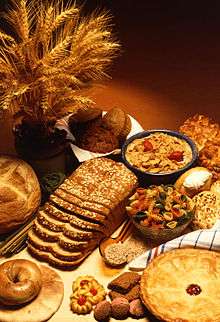Wheat middlings
Wheat middlings (also known as millfeed, wheat mill run, or wheat midds) are the product of the wheat milling process that is not flour. A good source of protein, fiber, phosphorus, and other nutrients, they are used to produce foods like pasta, breakfast cereals, puddings, and couscous for humans, as well as fodder for livestock and pets. [1] They are also being researched for use as a biofuel.
Production
White flour is made entirely from the endosperm or protein/starchy part of the grain (the grass fruit), leaving behind the germ or protein/fat/vitamin-rich part and the bran or fiber part. Wheat middlings comprise different fractions separated from these byproducts. In addition to marketing the bran and germ as products in their own right, middlings include shorts (making up approximately 12% of the original grain, consisting of fractions of endosperm, bran, and germ with an average particle size of 500-900 microns) and red dog (actually a low-grade flour, making up approximately 3% of the original grain, consisting of fractions of endosperm and bran, with an average particle size of 100-300 microns).[2]
The middlings include those portions of the wheat kernel that are richest in proteins, vitamins, lipids and minerals. For example, highly refined patent flour may contain only 10 to 12% of the total thiamine and niacin, 20% of the phosphorus, and 50% of the calcium of the parent grain.[3]
Classification inconsistencies
The term is somewhat imprecise, as it does not take into account the various mill streams and proportions that are combined and ultimately constitute the product's final composition. As a consequence of this inconsistent terminology, difficulties are encountered when ascertaining nutritional value and establishing economic worth. Wheat midds are sometimes referred to negatively as "floor sweepings" although such products are generally captured long before they would end up on the floor.
Human consumption
Durum semolina is a kind of wheat middlings made from durum wheat; it is used to produce pasta, breakfast cereals, puddings, and couscous.
Animal consumption
When used in feed for livestock or horses, middlings can be a good source of protein, fiber, phosphorus, and other nutrients. However, flour milling products arising from a fairly homogeneous parent grain can vary greatly depending on the objectives of the milling process. Thus, the degree of nutrient variation in wheat midds can be a major consideration in determining whether its inclusion in a ration or formula feed is beneficial.[1] It has 96 percent of the energy value of barley and 91 percent of the energy value of corn.[4] It is also used frequently as an inexpensive filler for pet food for animals such as dogs and cats, which do not digest wheat products as readily.
Fuels research
Due to its high energy content and low price, wheat middlings is being researched as a biofuel.[5]
Nutrition
| Nutrient Value[4] | ||
|---|---|---|
| Analysis | Percentage | |
| Dry matter | 89% | |
| Crude protein | 16.5% | |
| Crude fiber | 7.5% | |
| Neutral detergent fiber | 32% | |
Sources
- Wheat Middlings Composition, Feeding Value, and Storage Guidelines
- Dreher M (19 January 1999). "Food sources and uses of dietary fiber". In Cho, Susan Sungsoo; Prosky, Leon; Dreher, Mark (eds.). Complex Carbohydrates in Foods. New York: Marcel Dekker, Inc. pp. 358–359. ISBN 0824701879. Retrieved 3 September 2017.
- Shellenberger, J. A. 1970. Nutritional values of wheat and wheat by-products as affected by modern production and milling techniques. Proc. Intern. Symp. “Wheat in Livestock and Poultry Feeds.” June 18–19, Okla. State Univ. p. 34–41.
- Ingredients101
- Ohio State University
